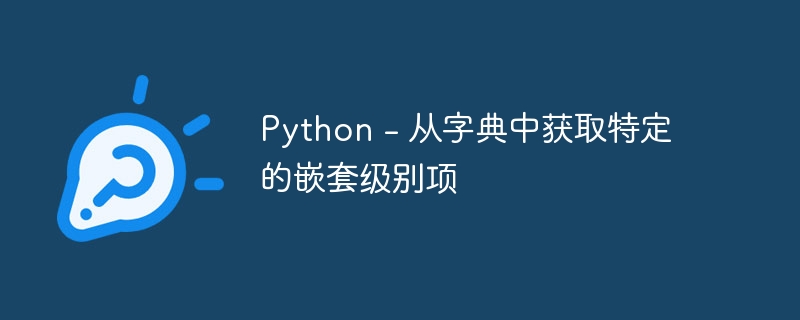Python - 从字典中获取特定的嵌套级别项
- PHPz转载
- 2023-08-20 14:37:131127浏览

在Python中,字典允许您存储键值对,从而轻松地组织和高效地访问数据。有时,我们可能需要从字典的嵌套级别中检索特定的项。我们可以使用isinstance()与递归方法和dict.get()方法从字典中获取嵌套级别的项。在本文中,我们将探讨从Python字典中获取特定嵌套级别项的不同方法。
嵌套字典
嵌套字典是一个包含其他字典作为值的字典。这允许创建层次结构,其中数据以树状方式组织。层次结构的每个级别表示一个键值对,值是另一个字典。从这样的结构中访问项需要通过树的级别进行导航的特定方法。
方法1:使用递归
By using the recursive method, we can easily retrieve items from nested levels within a dictionary without explicitly specifying each level. It provides a flexible and efficient solution, especially when dealing with complex data structures.
算法
定义一个函数,我们称之为get_nested_item,它接受两个参数:字典数据和表示嵌套层级的键列表。
检查键列表是否为空。如果是空的,返回数据,因为它表示所需嵌套级别的值。
否则,从键列表中获取第一个键
检查数据字典中是否存在该键。如果存在,则使用与该键对应的值作为新的数据参数以及键列表中剩余的键,递归调用get_nested_item函数。
如果键不存在,则返回None或默认值来表示未找到该项。
Example
的中文翻译为:示例
在下面的示例中,我们定义了get_nested_item函数,该函数接受数据字典和键列表作为参数。我们检查键列表是否为空;如果是,则返回数据值。否则,我们从键列表中获取第一个键,并检查它是否存在于数据字典中。如果存在,我们以相应的值作为新数据和键列表中剩余的键,递归调用get_nested_item函数。如果找不到键,则返回None。
def get_nested_item(data, keys):
if len(keys) == 0:
return data
key = keys[0]
if key in data:
return get_nested_item(data[key], keys[1:])
else:
return None
keys = ['employees', 'John', 'position']
position = get_nested_item(company_data, keys)
print(position)
输出
Manager
方法2:使用isinstance()和递归
isinstance()函数在Python中用于检查对象的类型。如果对象是指定类型的实例,则返回True,否则返回False。我们可以将此函数与递归一起使用,动态地遍历嵌套字典的层级。
算法
定义一个函数,我们称之为get_nested_item,它接受两个参数:字典数据和表示嵌套层级的键列表。
检查键列表是否为空。如果是空的,返回数据,因为它表示所需嵌套级别的值。
否则,从键列表中获取第一个键。
使用 isinstance(data, dict) 检查数据是否是一个字典。如果是,使用对应键的值作为新的数据参数,并将剩余的键列表作为参数递归调用 get_nested_item 函数。
如果数据不是一个字典或者键不存在,则返回None或默认值来表示该项未找到。
Example
的中文翻译为:示例
在下面的示例中,我们使用 isinstance(data, dict) 来检查数据是否是一个字典。如果是,我们继续递归调用 get_nested_item。这个检查确保我们在导航有效的字典层级时避免遇到访问不存在的键时出现错误。
def get_nested_item(data, keys):
if len(keys) == 0:
return data
key = keys[0]
if isinstance(data, dict) and key in data:
return get_nested_item(data[key], keys[1:])
else:
return None
keys = ['employees', 'John', 'position']
position = get_nested_item(company_data, keys)
print(position)
输出
Manager
Method 3: Using dict.get() method
dict.get()方法是从字典中检索值并在找不到键时提供默认值的有用方式。与直接使用字典索引相比,特别是在处理嵌套字典或不知道键是否存在时,它是一种更简洁和安全的方法。
Example
的中文翻译为:示例
In the below example, we have a nested dictionary company_data representing employee information. We use company_data.get('employees', {}).get('John', {}).get('position', 'Unknown') to retrieve the position of employee 'John'. By using dict.get() at each level, we ensure that the code easily handles missing keys without raising an error. In case any key is missing, the default value 'Unknown' is returned.
company_data = {
'employees': {
'John': {
'age': 30,
'position': 'Manager',
'department': 'Sales'
},
'Emily': {
'age': 25,
'position': 'Developer',
'department': 'IT'
}
}
}
position = company_data.get('employees', {}).get('John', {}).get('position', 'Unknown')
print(position)
输出
Manager
结论
在本文中,我们讨论了如何使用递归、isinstance和递归方法以及使用dict.get()方法从字典中获取特定的嵌套级别项。当你对一个键的存在不确定或者想要轻松处理缺失的键时,dict.get()方法特别有用。isinstance()函数和递归使我们能够高效地遍历嵌套的字典。
以上是Python - 从字典中获取特定的嵌套级别项的详细内容。更多信息请关注PHP中文网其他相关文章!

